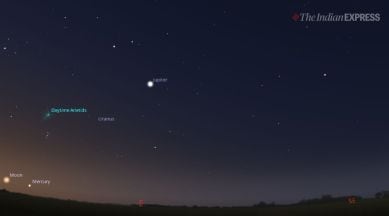5 planets to align in the sky: How to spot them
5 planets are set to align in the sky early on June 17. While two of them would be especially difficult to spot, here is how you can look for them before the sun rises on Saturday.

Mercury, Jupiter, Saturn, Uranus and Neptune are set to align in the sky on Saturday morning (June 16), creating a spectacular celestial sight for those who will be able to spot the five planets.
Many reports rightly say that the five planets will line up in the night sky. But most of them gloss over the fact that actually spotting them will be difficult for all but the most experienced skywatchers. Two of the planets—Uranus and Neptune—will only be visible with some extra help in the form of binoculars or a telescope, according to EarthSky.
monthly limit of free stories.
with an Express account.
How to view the five-planet alignment in the night sky
It will be easiest to spot the five-planet alignment in the Southern Hemisphere of the globe, according to New Scientist. This is because it is currently winter in the southern hemisphere and therefore, skywatchers will have more time to search for the planets.
To get the best view of this rare celestial alignment, go to a location with less light pollution and a clear view of the horizon, unobstructed by geography and foliage. It would be best to reach there around a couple of hours before sunrise so that you have enough time to scope out all the planets till you can spot Mercury, which will come above the horizon last, according to Time.
Jupiter will be bright and should be the easiest to spot, according to EarthSky. It should be low in the eastern part of the sky and would be the brightest object in the part of the sky unless you are looking at a streetlight. Saturn will be higher and further South compared to Jupiter. It should also be relatively easy to spot since it will be in the constellation Capricornus, which does not have any stars brighter than the planet.
Mercury will probably be the only other planet that you would be able to spot with the unaided eye. To spot the first planet from the Sun, an unobstructed view of the horizon in east and northeast directions would be essential. It will be brighter than Saturn in theory but could get more difficult to spot since it will be low in the sky as it begins to brighten with dawn.
Uranus will be the second-dimmest planet among the five and it will also have the disadvantage of being close to the rising sun. While Neptune will be the least bright among the planets, it will be higher in the sky. It will lie in the constellation Pisces. Both Uranus and Neptune could be next to impossible to spot with the unaided eye so try to bring along a telescope or atleast a pair of binoculars.